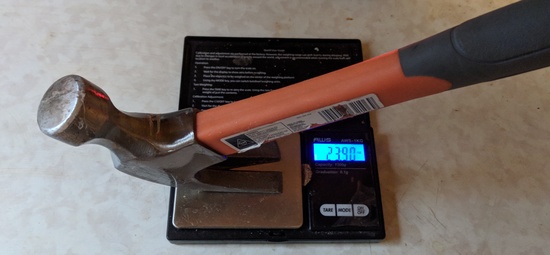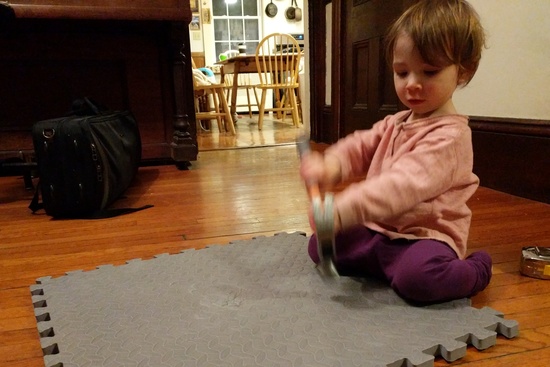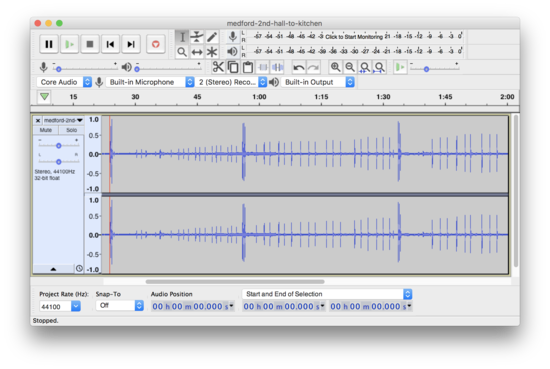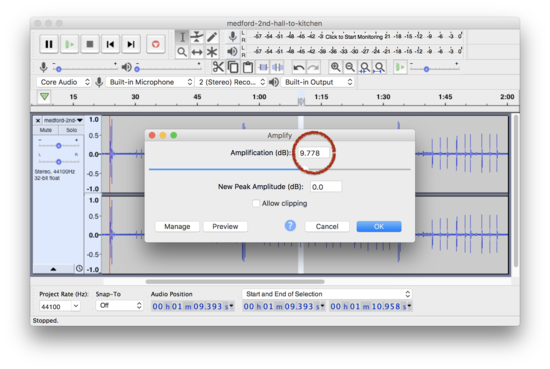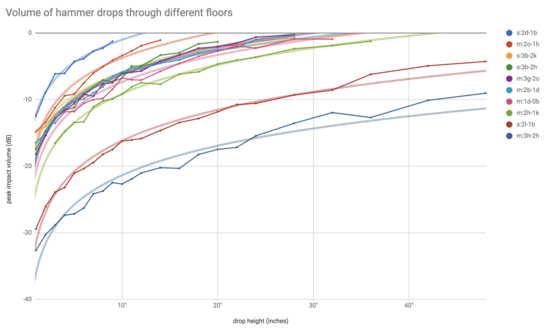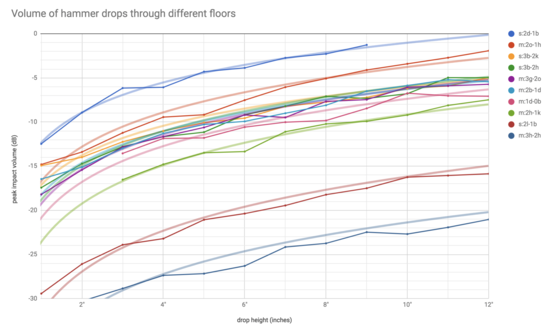Measuring Sound Transmission Through Floors |
February 7th, 2018 |
| house |
In the room below, I set up my laptop (2017 MacBook Pro 15") with Audacity recording. I made sure ambient noise reduction was turned off, and I set the mic volume to 10%. I put the laptop on a pillow so it only would record vibrations through the air.
In the room above, I dropped a hammer onto a mat from a variety of heights. I used a "16oz" hammer, which weighed 23.9oz including the handle:
I dropped it head first onto a 0.5" EVA foam mat.
I dropped three times at each height, and after the 6", 12", 24", and 48" drops hit the mat hard three times so I could tell where I was when looking back at the recording.
I took samples from a range of places in our house (Somerville) and my dad's house (Medford), three story wood frame houses from 1920 and 1895 respectively.
The recordings are:
- Somerville: dining room to 1st floor bedroom (s:2d-1b)
- Medford: office to front hall (m:2o-1h)
- Somerville: Anna's bedroom to 2nd floor kitchen (s:3b-2k)
- Somerville: Jeff and Julia's bedroom to 2nd floor hall (s:3b-2h)
- Medford: guest room to office (m:3g-2o)
- Medford: Rick's bedroom to dining room (m:2b-1d)
- Medford: dining room to basement (m:1d-0b)
- Medford: second floor hallway to kitchen (m:2h-1k)
- Somerville: living room to 1st floor bedroom (s:2l-1b)
- Medford: 3rd floor hallway to 2nd floor hallway (m:3h-2h)
I went back over the recordings in Audacity and measured the heights
of the peaks using the Effect > Amplify tool (which I made
a shortcut for) which, as a side-effect, tells you how loud the sample
currently is.
The raw data is here, in a shared spreadsheet. Blank cells at the low end are ones I couldn't distinguish from background noise, blank cells at the high end are ones where it was too loud for the mic (clipping) for any one of the three samples, and blank cells in the middle (0.5%) were times I dropped the hammer wrong and lost a measurement.
This was a consistent enough process that I think I would get the same results if I repeated it, and I definitely think it's good enough to measure relative rates of sound transmission. It's not calibrated to any external scale, though.
Overall, rooms varied widely in how much sound was transferred:
As you'd expect from a measurement with a log scale, a log trendline fits pretty well:
Reading the trendlines off the graph at 6", from worst to best I see:
- Somerville: dining room to 1st floor bedroom (s:2d-1b): -3dB
- Medford: office to front hall (m:2o-1h): -6dB
- Somerville: Anna's bedroom to 2nd floor kitchen (s:3b-2k): -8dB
- Somerville: Jeff and Julia's bedroom to 2nd floor hall (s:3b-2h): -9dB
- Medford: guest room to office (m:3g-2o): -9dB
- Medford: Rick's bedroom to dining room (m:2b-1d): -9dB
- Medford: dining room to basement (m:1d-0b): -10dB
- Medford: second floor hallway to kitchen (m:2h-1k): -12dB
- Somerville: living room to 1st floor bedroom (s:2l-1b): -19dB
- Medford: 3rd floor hallway to 2nd floor hallway (m:3h-2h): -24dB
Update 2018-02-08: I took some more measurements, this time all at 6" since it seems like that's enough to characterize it. I wanted to get a better sense of how transmission worked into the first floor living room and bedroom from the second floor living room and kitchen. I measured:
Update 2018-02-24: We decided to redo the first floor bedroom ceiling, and the demolition is done now. The ceiling turned out to be 3/8 drywall, attached to 3/4" strapping. (No silliness with the old wood lathe like there was in the front hall.) I took more 6" measurements. Some of the dining room to bedroom measurements clipped, but it looks to me like Audacity was able to correct for this, and the negative numbers I got from the Amplify tool look like they come from some kind of wave reconstruction? Here's the data, with the data from earlier to compare with. All of these were measured in the 1st floor bedroom:
| place | pre demo | post demo | delta |
|---|---|---|---|
| Dining room edge | -6.6dB | -0.8dB | +5.8dB |
| Dining room middle | -7.4dB | -2.5dB | +4.9dB |
| Living room middle | -19dB | -7.7dB | +11.3dB |
| Kitchen middle | -24.1dB | -13.5dB | +10.6dB |
| Kitchen edge | -16.9dB | -13.2dB | +3.7dB |
The two dining room measurements are the most important ones, since that's where things were the worst to begin with. It looks like the old ceiling was getting us about 5.5dB of impact sound reduction. Additionally, speech above is way more audible than it was before the demo.
Update 2018-03-18: Some of the new ceiling is up: the joists have been stiffened with 12" wide strips of 3/4" plywood, there are two layers of 5/8" drywall and green glue screwed to the underside of the subfloor, and there's 6" of fiberglass insulation under that. I took another round of measurements:
| place | pre demo | post 6" insulation | delta |
|---|---|---|---|
| Dining room edge | -6.6dB | -10.4dB | -3.8dB |
| Dining room middle | -7.4dB | -16dB | -8.5dB |
| Living room middle | -19dB | -19dB | 0dB |
| Kitchen middle | -24dB | -27dB | -2.8dB |
| Kitchen edge | -17dB | -22dB | -4.4dB |
This has me optimistic: we still have two layers of 5/8" drywall with green glue hung from RSIC clips to go and we're already better than before we started.
Update 2018-03-19: Since I'm dropping the ceiling by a bit over a foot I was thinking I might as well put in more insulation. I went back and added another 6", bringing the total to 12", and took yet another round of measurements:
| place | pre demo | post 6" insulation | post 12" insulation | delta pre-post | delta 6" to 12" |
|---|---|---|---|---|---|
| Dining room edge | -6.6dB | -10.4dB | -13.4dB | -6.8dB | -3.0dB |
| Dining room middle | -7.4dB | -16dB | -18.6dB | -11.2dB | -2.6dB |
| Living room middle | -19dB | -19dB | -21.72dB | -2.7dB | -2.7dB |
| Kitchen middle | -24dB | -27dB | -29.8dB | -5.8dB | -2.8dB |
| Kitchen edge | -17dB | -22dB | -24.6dB | -7.6dB | -2.6dB |
This is even better! I think part of what's happening here is that this layer of insulation is able to go under partly under the joists (it's resting on top of the hat channel) while the other was entirely between the joists.
Thoughts:
The bedroom in question has the most sound transfer (s:2d-1b) of all the measurements I took.
The s:2l-1b measurement is the only one that isn't to a room directly below. It's Like s:2d-1b, but from one room over (our living room instead of our dining room. It looks like moving over a room saves 16dB.
The Somerville house has had a lot of the original plaster replaced with drywall; the Medford house is still all plaster. I think this is the main reason the Medford house tends to do a little better.
Making the bedroom ceiling to be more like a typical ceiling (basically, putting on another layer of drywall) would make things better by about 6dB.
It's hard to say how much better various forms of drop ceilings would do. Do I know anyone who has similar parts of their house with and without a drop ceiling that I could compare? Maybe a ceiling put in to hide water damage?
Update 2018-04-29: it's done.
Comment via: google plus, facebook, substack
